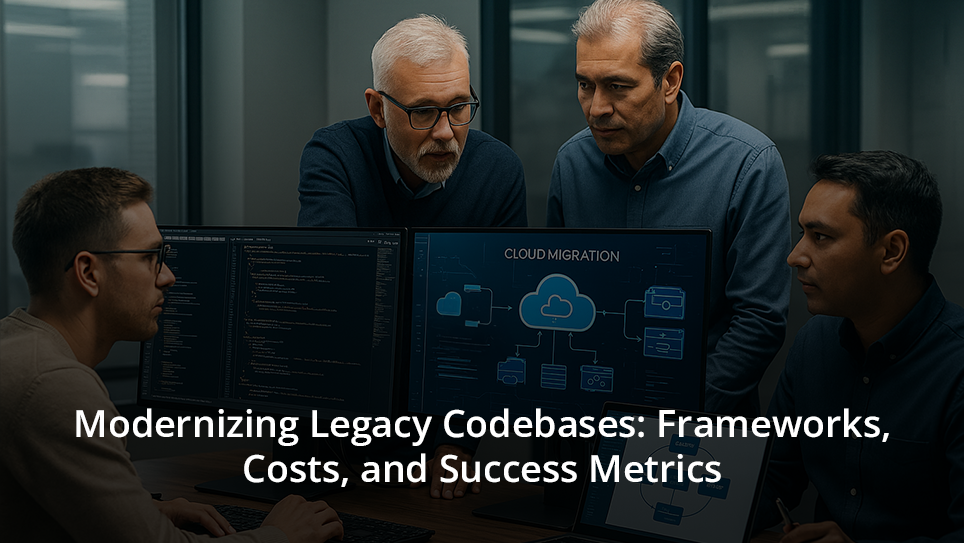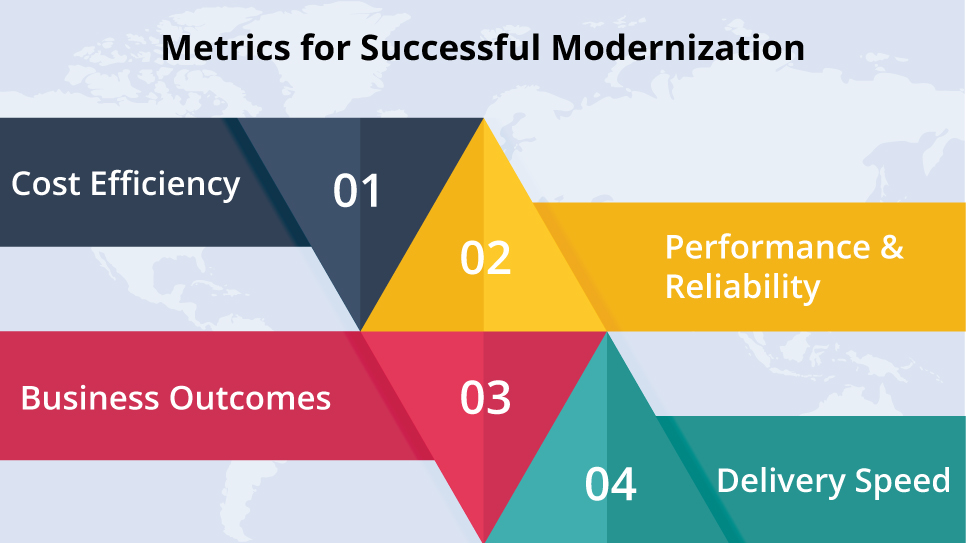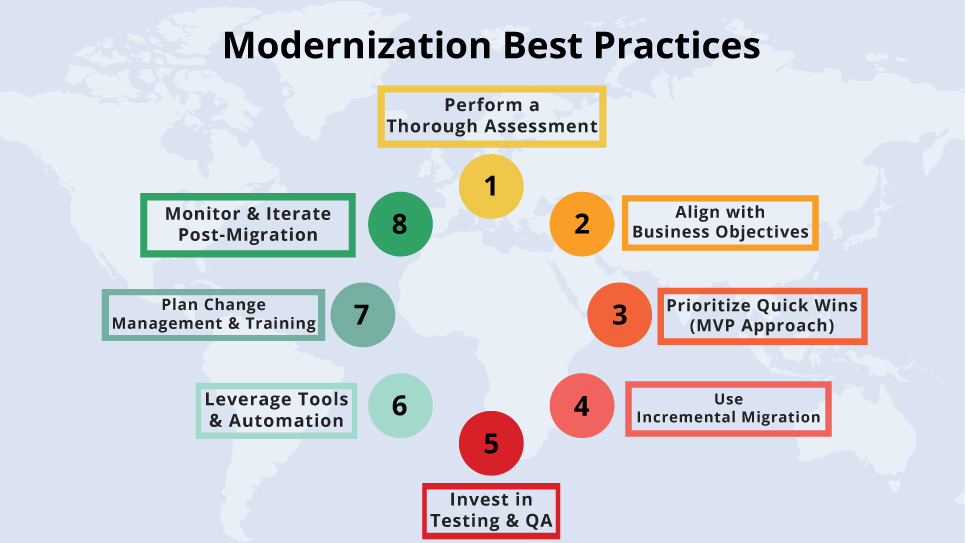Modernizing Legacy Codebases: Frameworks, Costs, and Success Metrics

For several sectors, including Healthcare & Life Sciences, E-Commerce & Retail, Education, Travel and Hospitality, Finance, Telecommunication, Logistics and Transportation, Manufacturing and Construction, Gaming organizations have software so old that the systems can hardly meet modern demands. They slow down innovation, pose a threat to security, and escalate the maintenance cost. For companies to tangle in-groove with this fast-paced digital world, the modernization of legacy codebases has become imperative.
Yet legacy system modernization is a complex endeavor. It requires a clear strategy or framework to guide the process, careful consideration of the cost of refactoring legacy code, and well-defined metrics for successful modernization to ensure the effort delivers business value. In this article, we explore effective legacy system modernization frameworks and discuss how to manage the costs. We also outline key metrics to gauge modernization success. Additionally, we look at approaches for legacy to modern architecture migration, examine the challenges in upgrading legacy software, and share modernization best practices, including how generative AI and MVP approaches can reduce risk and improve ROI.
Legacy System Modernization Frameworks
The legacy system modernization frameworks provide industries with the structured means for the orderly phasing out of obsolete systems while at the same time cutting costs and building scalability. Popular among these systems is the seven Rs model (Retain, Retire, Rehosting, Re-Platforming, Refactoring/Re-Architecting, and Repurchasing), which is used to assign an appropriate modernization strategy to every application.
Decision-making then goes towards weighing the benefits of incremental replacement vs. a full replacement. Incremental methods, such as the Strangler Fig pattern, slowly replace components, allowing parallel operation of legacy and new systems in an attempt to minimize risks. Full rewrites provide for a clean slate much faster, but carry a heavier short-term risk.
Given these frameworks, the choice of the tech stack and architecture becomes paramount. There is a tendency to lift from a monolithic on-prem environment and thrust into a cloud-ready and modular setup, such as microservices. Aging codebases (COBOL, for instance) may find their way to the new architecture comprised of modern languages (Java, Python), aligning with contemporary skill sets and long-term objectives.
Ideally, such a framework will guarantee that every modernisation step is tied to business outcomes, bearing much less risk and permanent scalability growth.
The Cost of Refactoring Legacy Code
Refactoring legacy code often requires significant investment, influenced by system size, technical debt, and outdated technologies. Untangling millions of poorly documented lines can mean high labor costs.
Yet, sticking with old systems is even costlier. Legacy platforms eat up to 60% of IT budgets, drain productivity, increase security risks, and limit innovation. The opportunity cost of not modernizing can far outweigh refactoring expenses.
If seen from the perspective of investment, modernization will yield. IBM reports that modernization of applications can slash up to 30-50% of maintenance and operational costs. In a cloud-based setup, a huge amount of money in the running of data centers is replaced with scalable infrastructure that works in a pay-as-you-use mode.
For costs to be managed, focus should be placed on areas bearing more impact, then phasing the whole project through ROI-oriented decisions. Agile promotes incremental delivery of benefits, while platforms such as Coderbotics AI mitigate manual effort, automated code analysis, and refactoring risks.
Metrics for Successful Modernization

Measuring modernization success requires clear, trackable metrics from the start:
- Cost Efficiency: Track reductions in support, licensing, and hardware costs. Many projects aim for a 30–50% cut in maintenance spend.
- Performance & Reliability: Monitor faster response times, higher throughput, and uptime (e.g., 99.9% availability after cloud migration).
- Business Outcomes: Tie results to KPIs like revenue growth, customer satisfaction, retention, or conversion improvements.
- Delivery Speed: Measure deployment frequency, lead times, and bug reduction. Modern DevOps pipelines and microservices can cut release cycles by up to 80%.
Capturing baselines before modernization and comparing after implementation ensures progress is real and aligned with business goals.
Legacy to Modern Architecture Migration
The migration from legacy to modern architecture is at the core of a modernization initiative. Monolithic, on-premise systems are re-imagined as modular, scalable, and cloud-first designs to bring agility, resilience, and growth into the long term.
- From Monoliths to Microservices:
Breaking apart a big, tightly coupled code base into loosely coupled microservices communicating via APIs allows these services to be built, scaled, or updated independently, thus enhancing their resilience while giving speed to developers who sometimes develop several services in parallel. - Cloud-Centric Transformation:
Moving away from on-premises servers to public, private, or hybrid clouds (sometimes AWS, Azure, or GCP) spells elasticity and cost advantage; and refactoring into containers (Docker/Kubernetes) or serverless functions must be considered since automatic scaling, handling of enormous spikes in usage, cloud-native monitoring, security, and disaster recovery come from such a foundation. - Modern Data Architecture:
Outdated databases are usually incapable of handling the scale required now. Migration involves moving to modern relational, NoSQL, or real-time data platforms. Legacy data is then preserved, cleansed, and optimized for analytics, AI, and real-time decision-making. - Phased Migration (Strangler Fig Approach):
Rather than a risky “big bang” shift, many teams gradually introduce microservices or APIs in front of legacy systems. Functionality is diverted step by step until the old system can be retired — minimizing downtime and reducing risk. - Integration as a Priority:
Legacy apps often touch countless external systems. During migration, re-establishing these integrations (via APIs, middleware, or event-driven architectures) ensures seamless continuity and avoids critical disruptions.
In short, legacy to modern architecture migration is about more than just “moving to the cloud.” It’s a holistic re-architecture, combining microservices, cloud-native tech, and modern data strategies to create systems that are scalable, secure, and future-ready.
Challenges in Upgrading Legacy Software
Upgrading, or some would say, replacing legacy software is indeed dreadful. Knowing what may go wrong during an upgrade beforehand allows for the preparation of effective mitigation strategies. Some old challenges faced when upgrading legacy software include these:
- Lack of Documentation and Knowledge: Many legacy systems work without updated documentation from their developers; thus, such gaps in knowledge foster unpredictable environments and contribute to greater peril.
- Dependency and Compatibility Issues: In other words, a legacy application is usually tightly coupled with old systems, OSs, or hardware, and upgrades procure broken integrations or the necessity for complex data conversion.
- Downtime Risk: Core systems are executing some critical business operations, and the minute they go down for just a couple of seconds during an upgrade spell, we may lose so much in business, and hence it is essential to plan for parallel runs.
- Data Migration and Integrity: When moving huge volumes of data through transformation processes to new systems, there may be risks of loss, corruption, and breaches of compliance if such movements are not well managed through proper mapping, transformation, and validation.
- Change Resistance: Users resist new systems partly because they are used to the old ones and partly because it means a learning curve for them. Without decent change management programs and training, the adoption rate could be slow, or worse, negative.
- Scope Creep & Complexity: Projects grow as hidden issues emerge, leading to delays and overspending. Many modernization initiatives deliver less value than expected.
- Security & Compliance Risks: New systems can introduce vulnerabilities or non-compliance if not managed carefully. Meeting regulations from day one adds pressure.
Thorough planning, stakeholder involvement, and phased approaches help reduce these risks and keep modernization efforts on track.
Modernization Best Practices

While every legacy modernization project is unique, there are proven best practices that increase the likelihood of success. These practices help organizations navigate the complexities and avoid common pitfalls:
- Perform a Thorough Assessment:
Audit legacy systems to map components, dependencies, and risks. Use code analysis, team interviews, and data-flow mapping to identify gaps and prioritize fixes. - Align with Business Objectives:
Tie modernization goals directly to business outcomes like cost reduction, faster services, or improved customer experience. Keep stakeholders involved to secure buy-in. - Prioritize Quick Wins (MVP Approach):
Don’t modernize everything at once. Start with small, high-impact modules as pilots. Partner with an MVP development agency to deliver fast results and gather feedback. - Use Incremental Migration:
Adopt phased strategies like the Strangler Fig pattern or parallel runs. This reduces risk, allows rollbacks, and delivers benefits sooner without full cutovers. - Invest in Testing & QA:
Automated unit, integration, performance, and security tests are critical. Use CI/CD pipelines to catch issues early and ensure new systems outperform the old reliably. - Leverage Tools & Automation:
Adopt infrastructure-as-code, monitoring, and AI-powered tools like Coderbotics AI for faster refactoring. Add AI prototyping services and generative AI-enabled software development to test ideas quickly. - Plan Change Management & Training:
Communicate early, provide training, and involve “champions” to help peers adapt. Treat it as a business initiative, not just an IT project, to drive adoption smoothly. - Monitor & Iterate Post-Migration:
After launch, track success metrics, fix issues quickly, and plan for continuous improvement. Treat modernization as ongoing, not one-and-done.
By following these best practices, from careful planning and incremental delivery to harnessing new technology like AI and cloud, companies greatly improve their odds of a smooth and successful legacy modernization. It transforms what could be a high-risk overhaul into a manageable, strategically guided process.
Conclusion
Legacy system modernization isn’t just about keeping up with technology; it delivers tangible business results. Take a hypothetical example: before modernization, a company might spend $500,000 annually on maintenance, face 20 hours of downtime a year, operate on a 4-week release cycle, and deal with a 5% process error rate. Integration points may number around 50, with many outdated, and user satisfaction might hover at just 6/10. After modernization, the picture changes dramatically. Annual maintenance costs drop by 40% to $300,000, generating $200,000 in savings. Downtime falls to just 2 hours a year, saving another $180,000 annually in lost productivity. Release cycles accelerate from once every 4 weeks to once a week, boosting annual releases from 13 to 52. Errors in processes are cut from 5% to just 1%, while integration points are streamlined from 50 to 30 using modern APIs. Most importantly, user satisfaction climbs to 9/10, reflecting smoother functionality and more reliable performance. Altogether, these improvements yield $380,000 in annual cost savings, a 90% reduction in downtime, 80% fewer errors, four times faster release cycles, and a significant jump in user satisfaction. This example highlights how modernization translates directly into cost efficiency, reliability, agility, and productivity, making it a strategic investment rather than just a technical upgrade.
Today, the difference comes from tools and expertise. With platforms such as Coderbotics AI speeding up migration and intelligent refactoring, and expert partners such as FX31 Labs helping to shape strategy, modernization goes quicker and with reduced risk and with much greater impact. If implemented well, not just the business logic gets saved; it gets a new lease of life to invest in growth, innovation, and long-term ROI.
Ready to future-proof the enterprise?
Partner with FX31 Labs and turn your legacy into a launchpad for tomorrow.
FAQ’s
1. What are common legacy system modernization frameworks?
Common frameworks include the 7 Rs model (Retain, Retire, Rehost, Relocate, Repurchase, Replatform, Refactor) and cloud adoption guides like AWS CAF or Azure WAF. These offer a structured roadmap, from simple lift-and-shift to full code refactor, helping organizations modernize with clear options instead of ad-hoc upgrades.
2. What is the cost of refactoring legacy code?
Costs vary by system size and complexity, often ranging from thousands to millions. Expenses come from rewriting, testing, and downtime risks. Still, modernization reduces long-term costs, up to 50% in maintenance savings, and improves efficiency. Phased refactoring and AI tools can help control costs.
3. What are the key metrics for successful modernization?
Success metrics include:
- Cost savings (lower maintenance/infra spend)
- Performance gains (faster response, higher uptime)
- Fewer errors & stronger security
- Business impact (revenue, user satisfaction)
- Faster delivery cycles (shorter release times)
Tracking baselines and improvements ensures modernization delivers measurable value.
4. What are the challenges in upgrading legacy software?
Challenges include poor documentation, fragile dependencies, data migration risks, and integration with old systems. Downtime fears and user resistance add pressure, while scope creep can bloat costs and timelines. Success requires phased migration, strong testing, governance, and change management.
